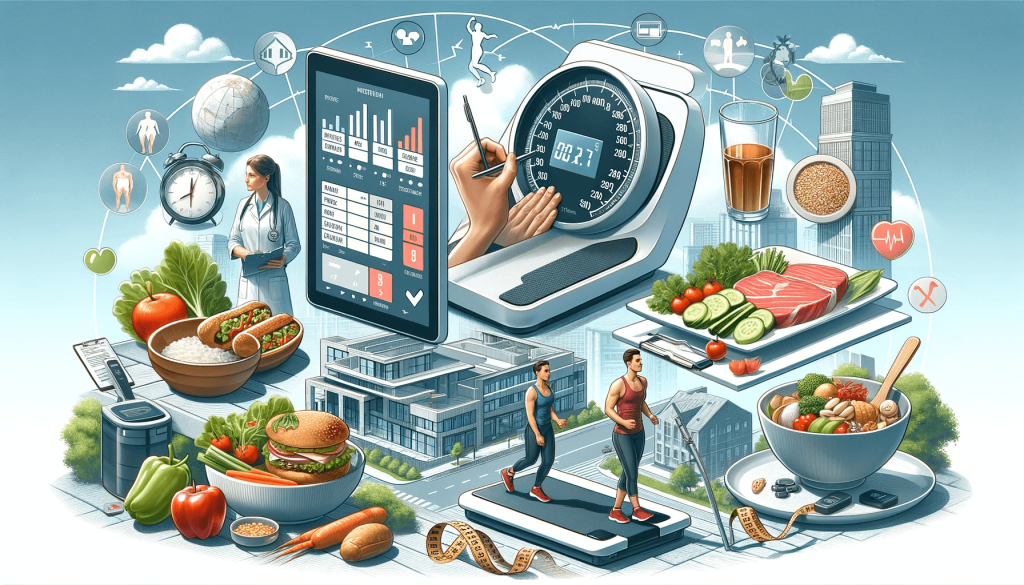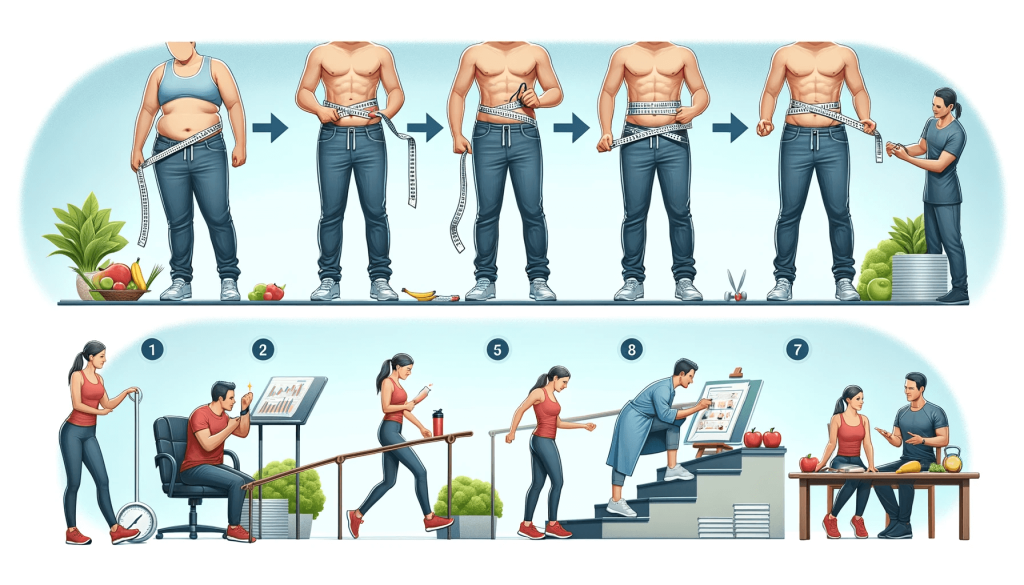
Did you know most people in the US try to lose weight four times a year? But only a few keep the weight off for good. This shows how hard it can be to stay healthy today.
On my own journey, I learned a lot about losing weight. By sharing what I’ve learned, I hope to help others lose weight too.
Contents
- 1 Key Takeaways
- 2 Understanding the Fundamentals of Weight Management
- 3 Types of Weight Loss: A Personal Perspective
- 4 Safe Weight Loss Techniques I Swear By
- 5 Natural Weight Loss Remedies vs. Modern Medicine
- 6 My Experience with Fast Weight Loss Strategies
- 7 Healthy Weight Loss Options for Long-Term Benefits
- 8 From Fad Diets to Sustainable Weight Loss Plans
- 9 Effective Weight Loss Methods: Balancing Diet and Exercise
- 10 Popular Weight Loss Programs: Which One Worked for Me?
- 11 Proven Weight Loss Solutions and Supporting Scientific Evidence
- 12 Integrating Weight Loss into a Busy Lifestyle
- 13 The Impact of Mindful Eating on My Weight Loss
- 14 Overcoming Weight Loss Plateaus with Persistence
- 15 Individualized Weight Loss: Tailoring the Approach to Fit Your Life
- 16 Source Links
Key Takeaways
- Identifying the right types of weight loss strategies is crucial for sustainable success.
- Personal insights are invaluable as they illustrate real-life applications of weight management principles.
- A balanced approach to eating and exercise is key to maintaining a successful health journey.
- Regular consultation with healthcare professionals can optimize weight loss efforts.
- Weight loss tips grounded in personal experience offer practical guidance for those looking to make lasting changes.
- Mindfulness and consistency in diet and lifestyle choices pave the way for natural and effective weight loss.
Understanding the Fundamentals of Weight Management

Starting a weight management journey is complex. It’s more than just picking the newest diet or exercise plan. Discovering effective weight loss methods has shown me that true health means changing your lifestyle for good. It’s essential to make choices based on good information, often with advice from health professionals, to ensure your plans match your health needs and aims.
Talking regularly with health pros can help. They point out the best treatments and changes for one’s health. So, finding a good mix of diet, exercise, and mental health tactics is not only doable but based on science and personal insight.
| Aspect of Weight Management | Guidelines | Objective |
|---|---|---|
| Diet | Personalized meal planning | Align with nutritional needs and preferences |
| Exercise | Structured fitness regimen | Support metabolism and muscle development |
| Behavioral | Setting realistic goals and staying motivated | Maintain progress and prevent fallbacks |
| Professional Support | Ongoing consultation and adaptation | Address individual health changes and concerns |
With help from health professionals, understanding weight management gets clearer. Mixing the right diet with exercise forms the basis for effective weight loss methods. These methods are likelier to last in the long run.
My experiences emphasize the importance of a planned approach. Every part of weight management is carefully customized and adjusted. This is based on regular health checks and personal progress. Such personalized and knowledgeable plans are key not just to losing weight, but to improving overall health.
Types of Weight Loss: A Personal Perspective
My health journey taught me a lot. I learned that simple fixes and fads don’t work well. Instead, natural weight loss remedies and sustainable weight loss plans showed real, lasting benefits.
The Role of Dieting in My Weight Loss Success
My diet was key to losing weight. It was important to enjoy what I ate. Instead of dull meals, I chose diverse, nutritious foods. Batch cooking helped me stay on track and avoid unhealthy options.
Finding the Best Exercise Routine for Sustainable Results
Exercise was crucial too. I found fun, effective workouts after some experimenting. Strength training was especially important. It made me stronger and, with enough rest, was a big part of my sustainable weight loss plan.
I looked into many popular weight loss programs. Some were helpful, but personalized plans worked best for me. Inflexible programs didn’t suit me. I preferred adaptable, natural approaches.
- Natural remedies and whole foods over processed alternatives
- Customized exercise routine emphasizing strength and recovery
- Mindfulness in dietary choices and portion sizes
| Meal Planning StrategyPhysical ActivityWeight Loss Program Type | ||
|---|---|---|
| Batch Cooking | Strength Training | Personalized Natural Remedy Focus |
| Nutritionally Balanced Meals | Adequate Sleep for Recovery | Flexible Popular Programs Adaptation |
Safe Weight Loss Techniques I Swear By

In my health journey, I found safe weight loss methods key for achieving my goals. A balanced diet, full of whole foods, is central. These foods keep energy up and cravings down.
Eating slowly has helped me digest better and feel fuller. It’s been huge in recognizing when I’m full. Also, knowing when I’m thirsty, not hungry, avoids unnecessary eating.
- Eating meals composed mostly of vegetables, lean proteins, and complex carbohydrates.
- Incorporating snacks that are rich in fiber and protein to sustain energy throughout the day.
- Ensuring that every meal is a mix from the vast colors of the produce spectrum to maximize nutrient intake.
I never skip meals now. It keeps my body’s balance and metabolism right. Eating regularly stops my body from slowing down my metabolism.
I’ve cut high-glycemic carbs, leveling my energy throughout the day. It improves my appetite control and overall health.
- Avoiding sweets and processed snacks high in sugar and empty calories.
- Choosing complex carbs like sweet potatoes, quinoa, and whole grains.
- Opting for fresh fruit when a craving for something sweet arises.
These safe weight loss techniques have helped me live healthier. They’re part of a bigger picture for my wellness. It’s about lasting health, not quick fixes.
Natural Weight Loss Remedies vs. Modern Medicine
I’ve explored weight loss through both old and new ways. I looked into natural remedies and modern medicines. Each has its pros and cons, based on my journey and lots of research.
Herbal Supplements I’ve Tried
I’ve used herbal supplements for weight loss. I tried Green Tea Extract and Garcinia Cambogia because they’re known to help with metabolism. They’ve had a kind of subtle effect on my weight. But I know they’re not as strictly checked as prescription medications.
Prescription Medications: Pros and Cons
Prescription medications like Orlistat and Phentermine have strong support from studies and the FDA. They work fast under a doctor’s watch. But, dealing with side effects and seeing doctors is part of it.
| Herbal Supplements | Prescription Medications |
|---|---|
| Often prefer natural ingredients | Chemically synthesized for targeted results |
| Less regulated by authorities | Strictly regulated and FDA-approved |
| May provide gradual benefits | Can offer quick and observable results |
| Varying levels of efficacy | Efficacy supported by clinical trials |
| Minimal to no side effects | Potential side effects and interactions |
My experiences with both herbal supplements and prescription medications varied. But, I think using both natural and modern methods is best. This way, I can stay healthy and lose weight effectively.
My Experience with Fast Weight Loss Strategies
In the fitness world, many are drawn to fast weight loss strategies for quick results. I learned that quick weight loss can seem great at first. But, it often doesn’t last and can have bad effects. Here’s why quick-fix diets don’t lead to long-term health.
- Fast weight loss strategies may yield immediate gratification but can undermine metabolism and overall health.
- Rapid shedding of pounds often involves water and muscle loss rather than fat, skewing body composition unfavorably.
- Lifestyle modifications that foster gradual weight reduction contribute to durable and healthier outcomes.
I’ve realized that lasting change takes time, not just quick fixes. Steady changes in diet and exercise are key. They help achieve real, lasting wellness.
Healthy Weight Loss Options for Long-Term Benefits

I found healthy weight loss options that truly changed my life. I focused on foods that were good for me over the long run. Central to this was eating whole foods and learning about portion control. These methods helped me lose weight and keep it off.
Incorporating Whole Foods into Daily Meals
Whole foods became the core of my diet. I started eating more fruits, veggies, lean meats, and grains. Each of these foods provided important nutrients:
- Fruits and vegetables: delivering essential vitamins and fiber
- Lean proteins: providing satiety and supporting muscle growth
- Whole grains: contributing to steady energy levels and digestion
Choosing whole foods improved the variety and taste of my meals too.
The Impact of Portion Control on My Journey
Portion control was key to losing weight. It helped me eat just enough without overdoing it. I used measuring cups and visual guides to help. This way, I ate well without eating too much.
Let’s compare my meal sizes before and after I controlled portions:
| Meal Component | Previous Portion Size | Adjusted Portion Size | Comments |
|---|---|---|---|
| Whole Grains (e.g., Brown Rice) | 1 cup | 1/2 cup | Halved to reduce calories and maintain satisfaction |
| Lean Protein (e.g., Chicken Breast) | 8 ounces | 5-6 ounces | Adjusted for adequate protein intake without excess |
| Vegetables (e.g., Broccoli) | 1/2 cup | 1-2 cups | Increased to boost fiber and fullness with fewer calories |
| Fruits (e.g., Apples) | 2 whole fruits | 1 whole fruit | Controlled to balance sugar intake and overall nutrition |
From Fad Diets to Sustainable Weight Loss Plans

I started with quick-fix diets, but they weren’t helpful for long. Fad diets lacked what I needed for lasting health. Then, I found sustainable weight loss plans. They focus on a variety of foods and a balanced life. I learned eating different foods and enjoying my diet beats strict, temporary diets.
Creating my sustainable weight loss plan taught me a lot. Diet variation kept my meals exciting and nutritious. It helped me not just lose weight but build a healthier lifestyle.
- Swap processed snacks for a mix of fruits, nuts, or yogurt
- Introduce whole grains and legumes for long-lasting energy
- Incorporate a variety of proteins to assist in muscle repair and growth
- Experiment with ethnic cuisines for new flavors and nutritional profiles
| Fad Diet Pitfalls | Sustainable PlanAdvantages |
|---|---|
| Temporary weight loss | Long-term health benefits |
| Nutritional deficiencies | Comprehensive nutrition |
| Metabolic disruption | Metabolic balance |
| Psychological strain | Mental and emotional wellness |
I gave up the false hope of fad diets for real health. Adding variety means I get all needed nutrients and enjoy my meals. This changed me deeply. Now, I’m healthier and happier. My weight is stable because of my lifestyle choices.
Effective Weight Loss Methods: Balancing Diet and Exercise
Starting a journey to a balanced lifestyle needs a mix of diet and exercise. It’s like a dance of eating nutritiously dense foods and doing exercises. This mix keeps us healthy and full of energy.
My routine combines food rules and exercise tips. I keep adjusting to stay strong and lead a rich life. Diet and exercise changed my view of being healthy. They work together like this:
| Dietary Focus | Exercise Equivalents |
|---|---|
| Consumption of nutritiously dense foods like leafy greens, berries, lean proteins | Moderate-intensity cardio exercises such as brisk walking, swimming, cycling |
| Appropriate portion sizes to avoid overeating while satisfying nutritional needs | Strength training to build muscle mass and improve metabolism |
| Inclusion of healthy fats from avocados, nuts, and seeds for satiety and energy | Yoga or Pilates for flexibility and core strength, complementing more intense workouts |
| Limiting added sugars and refined carbs to prevent spikes in blood sugar levels | High-intensity interval training (HIIT) to maximize calorie burn and boost endurance |
Thinking about how diet and exercise match made me believe in a balanced lifestyle. I changed my habits to eat different nutritiously dense foods. I also changed my workouts. This helped me keep up my weight loss in a good way. I learned that balancing what you eat and how you move is key.
Popular Weight Loss Programs: Which One Worked for Me?

Throughout my journey, I tried many popular weight loss programs. Each program had its own rules and ideas. However, a weight loss regimen that looked at my personal needs made a big difference. I found success with strategies that matched my way of life.
The DASH diet caught my attention first. It focuses on many nutrients and a healthy heart. This approach is good for overall health and fits well into daily routines. You can read more about its benefits here.
Each person has different dietary needs. For 1-2% of Americans with celiac disease, eating gluten-free is a must. I chose my diet by understanding these unique needs.
- Intermittent fasting was new to me. It alternates between fasting and eating, which helped manage my weight.
- The MIND diet cares about brain health. It’s good for all ages and offers nutritious eating.
- Mindful eating made me think more about my food choices. It led to better, more enjoyable eating.
- Adopting the Paleo diet’s ideas, I looked back at our ancestors’ eating habits for guidance.
The mixing of these ideas into one weight loss regimen showed my liking for a full approach. Below, you’ll see a table comparing the diets I tried:
| Diet | Core Principle | Health Benefit |
|---|---|---|
| DASH | Heart-healthy, nutrient-rich | Reduces blood pressure, supports cardiovascular health |
| Gluten-Free | Excludes gluten | Needed for celiac disease, cuts down inflammation for some |
| Intermittent Fasting | Cycles of fasting and eating | Leads to weight loss, better metabolic health |
| MIND | Neuroprotective | Fights cognitive decline, helps brain health |
| Mindful Eating | Awareness and satisfaction | Helps control eating, stops overeating |
| Paleo | Ancient dietary habits | Boosts overall health, follows evolutionary nutrition |
Looking for balance, I discovered many paths. But the key was combining the right parts to form my own customized diet. It met my health goals and fit into my life well. This is how I found lasting success.
Proven Weight Loss Solutions and Supporting Scientific Evidence
Starting a weight loss journey can feel tough with all the advice out there. I found proven weight loss solutions that are based on scientific evidence. These solutions have helped me a lot, making me healthier and changing my life.
Scientifically-Backed Diet Regimens
I focused on diets proven by science. The key is eating whole foods and managing portions. This way, I eat right without feeling deprived or taking extreme steps.
Exercise Science: The Best Workouts for Fat Loss
The science of exercise has helped shape my weight loss plan. I learned that strength training combined with high-intensity workouts boosts metabolism. This doesn’t just help during exercise. It also keeps burning calories after the workout. This knowledge has helped me gain muscle and improve my body, which keeps me motivated.
Integrating Weight Loss into a Busy Lifestyle

For those of us always on the move, fitting weight loss into a busy lifestyle might seem tough. But with the right meal plans and workouts, it can work. It’s all about small, smart changes that fit our busy lives without hurting our health goals.
Meal Planning and Preparation Strategies
Meal planning is key for eating healthy when busy. Spending a few hours on meal prep each week is a lifesaver. It keeps me from choosing fast, unhealthy options.
- Batch Cooking: I cook lots at once to save time. This way, I have meals ready for the whole week.
- Healthy Snacks: Keeping healthy snacks close by helps me avoid bad choices. I love having nuts, yogurt, and fruits.
- Grocery List Essentials: I start with a list of fresh, whole foods. It makes shopping easier and helps me stay on track with my diet.
Quick and Effective Workouts for the Time-Poor Individual
Long workouts aren’t the only way to get fit. Short, intense exercises work great for me. They don’t take much time.
| Morning Routine | Lunch Break Boost | Evening Wind-Down |
|---|---|---|
| 10-minute HIIT session | 15-minute brisk walk | 10-minute yoga flow |
| Bodyweight exercises | Stair climbing | Stretching routine |
| Jump rope intervals | Park bench workouts | Guided meditation |
Adopting these methods is more than losing weight. It’s about building a lasting, healthy lifestyle. By focusing on meal planning and including quick workouts, I’m taking care of my health.
The Impact of Mindful Eating on My Weight Loss
During my weight loss, mindful eating changed my body and how I see meals. It helped me deal with satiety and emotional eating. I started to enjoy the taste and feel of food, savor every mouthful, and listen to when my body was really hungry.
Mindful eating really helps you feel full. Eating slowly and without distractions changed how satisfied I felt. I stopped eating by the clock. I ate when I was truly hungry and stopped when satisfied. This helped me lose weight in a lasting way.
Emotional eating used to control me, making me eat for comfort when stressed or bored. But mindfulness gave me the power to stop. By being mindful, I could tell apart real hunger from just wanting to eat. This greatly cut down my unnecessary snacking.
- Being more aware helped me control how much I ate
- Enjoying my food more meant I was happy with less
- Knowing what triggers my eating made me find better ways to cope
| Before Mindful Eating | After Mindful Eating |
|---|---|
| Often overate because I wasn’t paying attention | Eating less became easier because I felt fuller |
| Couldn’t tell if I was hungry or just emotional | Got better at sensing real hunger |
| Ate without thinking a lot | Became more deliberate about snacking |
Mindful eating is a journey for life, not a quick fix. It taught me a lot about myself and what my body needs. The benefits went beyond weight loss. They gave me peace with my food and how I eat.
Overcoming Weight Loss Plateaus with Persistence

Reaching a standstill in my weight loss journey was tough. But persistence was key instead of giving up. Weight loss plateaus are common, and I had to adjust my lifestyle to beat them.
Here’s how I managed to stay on track:
- Firstly, I added new foods and exercises to my regimen, shaking things up and preventing boredom.
- Secondly, proper hydration was critical, so I made sure to monitor my water intake carefully.
- Lastly, I set achievable, incremental goals to maintain motivation and charted small victories along the way.
These strategies helped me not just for a short time; they were for a lasting lifestyle change. Making these small yet important changes allowed me to overcome those tough plateaus.
Individualized Weight Loss: Tailoring the Approach to Fit Your Life
Weight management is unique for everyone. Individualized weight loss was my strategy. It was like tailoring a perfect-fit garment for my health and goals.
Evaluating Personal Health Conditions and Goals
I examined my health and what I wanted to achieve. It was more than losing weight. It was about improving my life for the long term. Understanding my health needs was key.
Customizing the Nutritional and Fitness Plan
I created a customized nutrition plan and a fitness routine. I picked meals I enjoyed that were also healthy. Matching my workouts with my daily life was important. This plan made long-term success more likely.